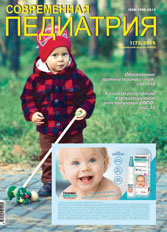Воспалительные паттерны крови как признак фенотипической неоднородности бронхиальной астмы у детей (обзор литературы)
DOI:
https://doi.org/10.15574/SP.2016.73.116Ключевые слова:
астма, дети, фенотип, воспалительные паттерны кровиАннотация
На основании анализа данных научной литературы обсуждаются патогенетические механизмы формирования фенотипов бронхиальной астмы в зависимости от характера воспаления дыхательных путей (эозинофильный и неэозинофильный). Приведены клинико-параклинические признаки указанных фенотипов по результатам цитологического исследования мокроты и воспалительных паттернов крови по данным собственных исследований. Показаны современные научные тенденции, акцентированы спорные моменты.
Библиографические ссылки
Bezrukov LO, Koloskova OK, Ortemenka EP. 2012. Comparative cytological analysis of sputum in children with bronchial asthma with eosinophilic and neutrophilic inflammation of airways. Zdorov'ye rebenka. 2(37): 28-30.
Guide of Allergy. Za red BM Pukhlika. K, TOV «Doktor-Medіa». 2011: 28.
Koloskova OK, Іvanova LA. 2012. Phenotypic features of asthma in school-age children. Perinatologiya i pediatriya. 3 (51): 96-98.
Antipkіn YuG, Lapshin FV, Umanets' TR et al. 2011. The new classification of asthma in children. Perinatologіya ta pedіatrіya. 1: 8-10.
Umanets TR, Lapshin VF. 2014. The modern concept of asthma phenotyping. Zdorov’ya Ukraїni. 1(28): 52-54.
Fedoseeva GB, Trofimova VI, Petrovoy MA. 2011. The Many Faces of asthma, Diagnosis, Treatment and Prevention. SPb, Nordmedizdat: 344.
Brown SD, Brown LA, Stephenson S et al. 2015. Characterization of a high TNF-α phenotype in children with moderate-to-severe asthma. J Allergy Clin Immunol. 135(6): 1651-1654.
Zedan M, Attia G, Zedan MM, Osman A et al. 2013. Clinical asthma phenotypes and therapeutic responses. ISRN Pediatrics: http://dx.doi.org/10.1155/2013/824781.
Cockcroft D, Davis B. 2009. Direct and indirect challenges in the clinical assessment of asthma. Ann Allergy Asthma Immunol. 103(5): 363-372.
Gereng EA, Sukhodolo I, Pleshko RI et al. 2004. Comparative study of eosinophils in the blood and induced sputum during bronchial asthma. Bull Exp Biol Med. 137: 50-52.
Wang F, He XY, Baines KJ et al. 2011. Different inflammatory phenotypes in adults and children with acute asthma. Eur Respir J. 38: 567-574.
Durrant MD, Metzger DW. 2010. Emerging roles of T helper subsets in the pathogenesis of asthma. Immunological Investigations. 39(4-5): 526 –549.
Dworski R, Simon H, Hoskins A еt al. 2011. Eosinophil and neutrophil extracellular DNA traps in human allergic asthmatic airways. J Allergy Clin Immunol. 127(5): 1260-1266.
Turner MO, Hussack P, Sears MR et al. 1995. Exacerbations of asthma without sputum eosinophilia. 50: 1057–1061.
Choy DF, Modrek B, Abbas AR et al. 2011. Gene Expression Patterns of Th2 Inflammation and Intercellular Communication in Asthmatic Airways. J Immunol. 186: 1861-1869.
Gibson PG. 2009. Tackling asthma phenotypes in community studies. Thorax. 64(5): 369-370. http://dx.doi.org/10.1136/thx.2008.109710; PMid:19401481
Gibson PG. 2009. Inflammatory phenotypes in adult asthma: clinical applications. The Clinical Respiratory Journal. 3: 198–206.
Global Strategy for Asthma Management and Prevention (updated 2012): Global Initiative for Asthma, 2012. http://www.ginasthma.org/local/uploads/files/GINA_Report_2012Feb13.pdf
Nadif R, Siroux V, Oryszczyn MP, Ravault C et al. 2009. Heterogeneity of asthma according to blood inflammatory patterns. Thorax. 64: 374–380.
Sol IS, Kim YH, Lee HS et al. 2014. Heterogeneity of asthma according to systemic inflammatory pattern in children. Allergy Asthma Respir Dis. 2(3): 165-170. http://dx.doi.org/10.4168/aard.2014.2.3.165
Kim YM, Kim YS, Jeon SG et al. 2013. Immunopathogenesis of Allergic Asthma: More Than the Th2 Hypothesis. Allergy Asthma Immunol Res. 5: 189-196.
Tsoumakidou M, Tzanakis N, Kyriakou D et al. 2004. Inflammatory cell profiles and T-lymphocyte subsets in chronic obstructive pulmonary disease and severe persistent asthma. Clin Exp Allergy. 34: 234-240.
Faria da Silva-Martins CL, Couto SC et al. 2013. Inhaled corticosteroid treatment for 6 months was not sufficient to normalize phagocytosis in asthmatic children. Clin Transl Allergy. 30; 3(1): 28-36.
Ly NP, Celedon JC. 2007. Family history, environmental exposures in early life, and childhood asthma. J Allergy Clin Immunol. 120: 271-272.
Mamessier E, Magnan N. 2006. Cytokines in atopic diseases: revisiting the Th2 dogma. Eur J Dermatol. 16(2): 103-113.
Monteseirнn J. 2009. Neutrophils and Asthma. J Investig Allergol Clin Immunol. 19(5): 340-354.
Yasui K, Kobayashi N, Yamazaki T, Koike K et al. 2005. Neutrophilic inflammation in childhood bronchial asthma. Thorax. 60: 704-705.
Kierstein S, Krytska K, Sharma S et al. 2008. Ozone inhalation induces exacerbation of eosinophilic airway inflammation and hyperresponsiveness in allergen-sensitized mice. Allergy. 63: 438-446.
Pelaia G, Vatrella A, Busceti MT. 2015. Cellular mechanisms underlying eosinophilic and neutrophilic airway inflammation in asthma. Hindawi Publishing Corporation Mediators of Inflammation: http://dx.doi.org/10.1155/2015/879783
Persson C. 2014. Primary lysis of eosinophils in severe desquamative asthma. Clin Exper Allergy. 44(2): 173–183. http://dx.doi.org/10.1111/cea.12255; PMid:24330324
Menzies D, Nair A, Williamson PA et al. 2006. Respiratory Symptoms, Pulmonary Function, and Markers of Inflammation Among Bar Workers Before and After a Legislative Ban on Smoking in Public Places. JAMA. 296: 1742-1748.
Porsbjerg C, von Llinstow M-L, Ulric CS, Nepper-Christensen S et al. 2006. Risk factors for onset of asthma: a 12-year prospective follow-up study. Chest. 129: 309-316.
Naseem A, Liaqat J, Zaidi SB et al. 2014. Sputum Neutrophilia in Severe Persistent Asthmatics. Journal of the College of Physicians and Surgeons Pakistan. 24(6): 420-423.
Bruijnzeel PL, Uddin M, Koenderman L et al. 2015. Targeting neutrophilic inflammation in severe neutrophilic asthma: can we target the disease-relevant neutrophil phenotype?. J Leukoc Biol. 4(2): 98-104. http://dx.doi.org/10.1189/jlb.3vmr1214-600rr
Manni ML, Trudeau JB, Scheller EV. 2014. The complex relationship between inflammation and lung function in severe asthma. Mucosal Immunology. 38: 10-38.
Wood L.G., Baines KJ, Fu J et al. 2012. The neutrophilic inflammatory phenotype is associated with systemic inflammation in asthma. Chest. 142(1): 86–93.
Weiss ST. 2012. New approaches to personalized medicine for asthma: Where are we? J Allergy Clin Immunol. 129: 327-334.

